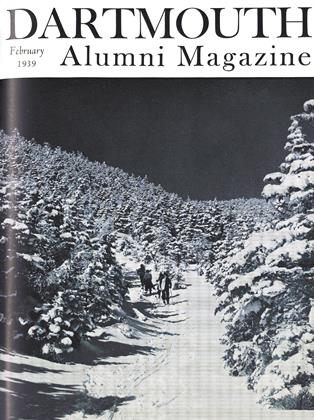HURRICANE DISCLOSES AGE OF ELMS AND CREATES A PARK MYSTERY
WHEN the storm of last September leveled most of the trees in College Park and a few of the elms about the center campus, the stumps and logs became interesting for what they might reveal through the number and width of their annual rings. In a slightly different sense than Hovey's "the granite of New Hampshire keeps a record of their fame," the old trees of the College keep a record of its football and baseball seasons—at least of their weather conditions as they appeal to growing plants. Planting and transplanting dates can also be determined fairly accurately by the ring counts from the center or from the band of narrowed rings where the young tree was recovering from the moving operation.
Around the campus, the fallen trees proved to be only moderately old as trees go. A few had been set about 1890 when they were five to ten years old. The one that fell on the porch of College Hall had only 73 rings in spite of its large trunk. The oldest to fall were the pair of 1 ls-year-olds in front of Robinson Hall, but the quaint, frail, 140-year-old Bartlett elm lost its crown and has been removed this winter.
CLASS TREES UNHARMED
In the Park, most of the class trees south of the Bema are standing; in fact, no tree with a marker went down. The lack of information about all the class trees makes an accurate report impossible and suggests the need for a complete catalogue of them.
The oldest tree felled by the storm was a sugar maple with 152 rings on the butt log. By chance the saw passed through a hole made when the young tree was tapped in 1822, according to the 116 rings outside the hole. This tree had been tapped so often that the next saw cut split another auger hole close by the first. A cross section to show all this will be kept on display in a Silsby corridor.
The records of College Park since its establishment in the 1860's were thought to be complete but from the fallen spruce, larch and pines has come an historical mystery—when were the first plantings made of the European trees that covered the ledges so well? According to the documents in our archives, Joel Parker, 1811, gave half of them in 1867 and half in 1868. They came from France as seedling trees, probably no more than a foot high. With due allowance for a stump cut slightly higher, there should be less than 70 rings on the Norway spruce, Austrian pine, Scotch pine and European larch; they are all alien trees, incapable of establishment by wind-borne seeds because parent trees of these species were not growing near the park. On the eastern and north-western sections of the area, these trees were all found to be under 70 years of age but on the slopes just north, south and east of the Tower the larch, spruce and Scotch pine had from 77 to 83 rings—with an average of at least 10 years too many years of growth!
The possibility that 10 or 12-year-old trees were brought from Europe by the thousand is most unlikely. Moreover, the rings give no indication of a transplanting in 1867 or 1868. There must have been an earlier planting of these foreign trees on the higher land around the Old Pine, probably in the late 1850's. Their success on the thin pasture soil may have led Judge Parker, a trustee at the time, to send for many more, like them. The mystery lies in the first planting—who planned and financed the work? As early as 1842 the Trustees adopted a policy of more trees for the campus and in 1855 they voted to keep the cows out of the area around the Old Pine but their records make no mention of trees for the park before the Parker gift arrived. If the problem trees were native to the region there would be no problem—shutting out the cows would let seedling trees start at once. Who did plant them?
It should be added for the record that an abundance of new trees will soon be growing in the Park. The old ones have been turned into lumber at the saw mill just beyond Dean Strong's place, the brush burned and most of the stumps removed like old teeth by tractor and truck. American born descendants of the same Norway spruce will be among the new settlers this coming spring, moved from the College nursery to the gaps between the occasional old survivors and the numerous young evergreens that have made a good start already. The Trees are dead. Long live the Trees!
 View Full Issue
View Full Issue
More From This Issue
-
 Sports
SportsBig Green Teams
February 1939 By Whitey Fuller '37 -
 Article
ArticleA Freshman Writes Home
February 1939 -
 Class Notes
Class Notes1937*
February 1939 By DONALD C. MCKINLAY -
 Class Notes
Class Notes1929*
February 1939 By F. WILLIAM ANDRES -
 Class Notes
Class Notes1921*
February 1939 By CHARLES A. STICKNEY JR. -
 Class Notes
Class Notes1918*
February 1939









